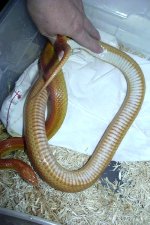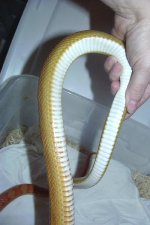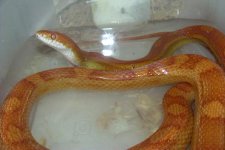MastersHaven said:
Hey Serp.
on that note, I have one question....
It is my understanding that some Sunglows are derived from Hypo lines, how is that possible?
What role does the Hypo have on the appearance of Sunglow and what is it's % of recurrence in the lines?

I hope that makes sense?!?!
:wavey:
I believe what happened is that some people decided to use hypos to start their sunglow lines because they offer a head start in reducing border size, and the goal in any "sunglow" project is obviously to get rid of the white on amels.
I think that amels will have some influence from the hypo gene, because I believe that hypo does have an effect of slowing the migration of the normally black areas, thus making the white areas smaller on amels to some degree or other. It might not be enough that you can visually pick out amels from hypo amels in a clutch, but I think it does have some influence.
However, it's also possible to eliminate the white areas through selective breeding, or using the motley or other pattern genes that affect the borders, so the end result is that creating a no-white amel (which is the widely used definition of sunglow) does not require the presence of the hypo gene.
As far as how common hypo is within sunglow lines, I used the search on the ACR to see what's there so far.
There are 49 snakes with the "sunglow" box checked.
Of these:
· 24 are listed as homozygous motley.
· 3 are listed as motley/stripe.
· 6 are listed as homozygous stripe.
* 2 are not listed as homozygous amel (genotypes were not included in the registration for those snakes)
One is listed as het hypo, and none are listed as homozygous hypo. About 1 in every 7 ACR corns is listed as hypo, so there's a good possibility that a few of those 49 sunglows are homozygous hypo and the owner didn't know it or list it.

Also note:
There are 21 snakes listed as homozygous for amel and hypo. 18 of these are also anerythristic so they wouldn't be listed as sunglows anyway, but none of the three remaining amel hypos are listed as sunglows either. (One is an amel hypo motley, even.)
Meanwhile:
There are 136 amel motleys listed, with 24 listed as sunglow.
There are 15 amel motley/stripes listed, with 3 listed as sunglow.
There are 73 amel stripes listed, with 6 listed as sunglow.
It will be fun to see what kinds of trends show themselves over the next few years.






